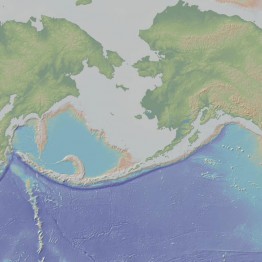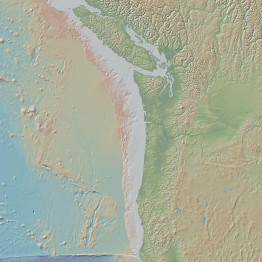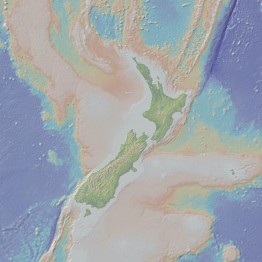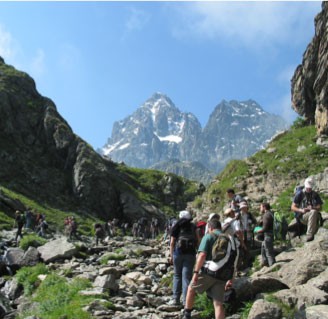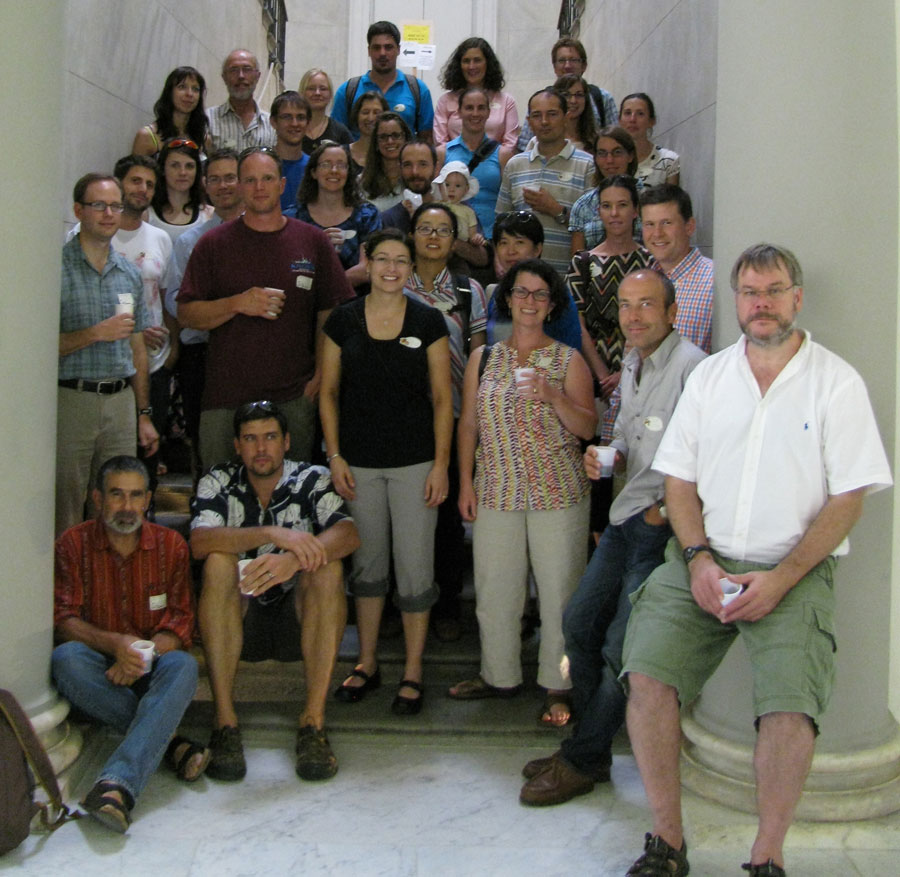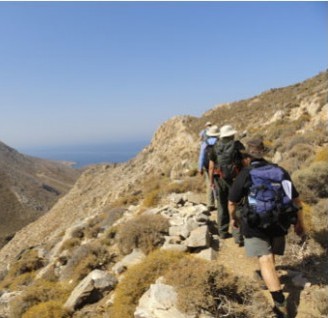The GeoPRISMS SCD Initiative addresses coupled processes active at subducting margins and explores linkages among them, spanning the updip limits of the accretionary wedge and incoming plate, to the deep mantle and plate boundary interface, and associated cycling of fluids and volatiles, their role in rheology, melting, and magmatism and ultimately, arc processes that lead to the growth of continental crust. This initiative formalizes the strong linkages between SEIZE and SubFac recognized during MARGINS and facilitate the interdisciplinary exchange of knowledge within the subduction zone community, enabling transformative discoveries of this highly coupled system.
Maps generated using GeoMapApp.
Click on each theme below to see current projects and some remarks on that theme from the GeoPRISMS Implementation Plan.
Studies at the GeoPRISMS Primary Sites will advance our understanding of physical processes and material properties that control fault slip behavior and deformation along subduction plate boundaries. Current hypotheses suggesting strong feedbacks between surface processes and subduction zone dynamics can be tested. GeoPRISMS has the potential to contribute significantly through data acquisition at the three primary sites, all of which produced great earthquakes in the past and/or exhibit significant variations in fault slip behavior and deformation history. The primary sites, however, are not sufficient to answer these questions on a global basis because of their limited diversity of slip behavior, site characteristics, and deformation history. The field of “comparative subductology” was founded on the observation more than 30 years ago that some subduction zones produce great earthquakes (Mw > 8, called “Chilean style”) while others do not (“Mariana style”). Although comparative subductology has identified several potential controls on slip behavior, it has shown that most subduction zones do not fall into the end-member groups. To extrapolate results from GeoPRISMS primary sites globally, a comparative subductology approach across multiple disciplines is necessary. Additionally, experimental and theoretical studies are essential toward understanding the controls on fault slip behavior, yet by definition these efforts are not tied to a single focus-site.
Therefore, in order to complement and extend insights gained from observations at primary sites, and to test hypotheses that arise from new data, laboratory and theoretical studies, comparative field studies, global comparisons, and targeted observations at non-primary subduction zones will be essential. Studies envisioned to meet this theme must be comparative (involving multiple active subduction zones, exhumed systems, or global) and interdisciplinary (including, where possible, thermo-mechanical and geochemical datasets). Ancient analogs, focused comparisons among the GeoPRISMS primary sites, and integration of results from the MARGINS focus sites (Nankai Trough, Izu-Bonin-Mariana, and Costa Rica) will allow more thorough hypothesis testing across disciplines. Detailed mapping, sampling, and laboratory analyses of exhumed fault zones will help correlate ancient subduction zone structure across a range of scales with specific slip processes, such as large earthquakes, ETS, or creep. Studies that exploit the recent surge of great earthquakes will provide new data on slip and deformation behavior over the co-seismic and post-seismic periods. Global comparisons of site characteristics (climate, convergence rate, crustal thickness, relief, volcanism, sediment types, supply and dispersal), particularly if such characteristics are not well represented within the primary sites, will be important for showing how sediment composition, exhumation, and erosion rates affect subduction margins. Laboratory studies should target the full spectrum of frictional, mechanical and diagenetic behavior of subduction zone materials. Other specific activities and datasets include: seismic and geodetic characterizations of slip events; 3-D mapping of stratigraphic positions of plate interfaces; high resolution bathymetry to identify variations in oceanic plate and forearc structures; surface deformation observations at subduction zones at different stages of the seismic cycle; gravity and magnetic data; heat flow and thermal history; mineral assemblages and recorded fluid and deformation processes along exhumed subduction faults and mantle wedges; low- and high-temperature deformation experiments on the effect of volatiles on slip behavior; laboratory measurements and deformation experiments on serpentine and other hydrated minerals; and modeling of the evolution of surface deformation and fault slip behavior over the seismic cycle.
The rheology and dynamics of the mantle wedge link the shallow subduction processes contributing to megathrust earthquakes to arc and back-arc processes. Devolatilization, deformation, and fluid/melt transport must fundamentally affect the dynamics of the mantle wedge, but broad-scale questions remain on the relative contribution of each. This theme focuses on integrating comparative field observations, thermal and numerical modeling, and laboratory observations to better constrain the maximum depth of plate interface decoupling (MDD), effect of serpentine or other hydrated minerals on wedge and interface strength, and flow geometry within the mantle wedge. The MDD, for example, dictates the trench-ward extent of mantle wedge flow, which in turn controls the thermal and petrologic structures of subduction zones. Flow geometry, if measured by seismic anisotropy, depends on water content, temperature and other parameters, even in an olivine-dominated lithology.
The GeoPRISMS primary sites provide excellent opportunities to gather the interdisciplinary datasets needed to characterize system-wide changes in thermal structure, volatile distribution, seismic observations of mantle flow, and hydration state of the wedge. These will aid in obtaining more accurate modeling of wedge dynamics along these margins. Of the GeoPRISMS primary sites, New Zealand has the oldest slab (~100 Ma), but it is primarily an oceanic plateau with an atypical crustal thickness (~15 km). Comparative, targeted geophysical observations of older, colder, and dryer subduction zones will also be necessary. Such studies should be limited to providing key missing datasets (surface heat flow, thermal modeling, velocity and attenuation images, anisotropy studies) in otherwise well-studied margins. Additional laboratory studies and numerical modeling are required to characterize mantle wedge dynamics and are themselves strongly linked. We do not yet understand how to distinguish between free fluid and hydrous minerals in seismic imaging, but these boundary conditions are fundamentally important in numerical simulations of the mantle wedge. Additional laboratory studies that provide data on the effect of water and volatiles on seismic properties, such as velocity or anisotropy, on typical mantle wedge assemblages are needed. Deformation experiments on materials along the slab-mantle interface could provide important constraints on numerical models exploring mechanisms that control the strength contrast between the plate interface and overriding mantle. Serpentinization of the mantle wedge and incoming oceanic plate is frequently invoked to explain strength changes along the subduction plate interface, but laboratory measurements and deformation experiments on serpentine minerals and other hydrated minerals are necessary to significantly advance our understanding of serpentinization and subduction dynamics in general, and mantle wedge dynamics in particular.
Volatile elements play a uniquely central role in the functioning of subduction zone processes at all levels. Although the identities of some key volatile-bearing phases (e.g., clays, serpentine, chlorite) are reasonably well-constrained, others are not (e.g., supercritical fluids or melts). Furthermore, critical constraints on the specific carriers, fluxes, and transport pathways of volatiles from their release at the slab, through the forearc and/or mantle wedge and upper plate lithosphere are largely missing. At their core, these questions cannot be addressed at any one focus site because the controlling factors are likely to be globally heterogeneous and may not be fully encompassed at the selected primary sites. For example, the variables that control serpentinization of the subducting lithosphere, and the extent to which serpentinization may control volatile fluxes into subduction zones, are as yet unknown. Thematic study of volatile fluxes will seek to identify a geochemical “smoking gun” for the contribution of such hydrous minerals to slab fluid composition and/or magma genesis, and allow the linkage of such tracers to geophysical and geochemical observations at the primary sites. In addition, geochemical and geochronological study of high-pressure metamorphic rocks can yield information regarding the rates and extents of loss (or retention) of volatiles to subarc depths and the isotopic compositions of volatiles entering the subarc mantle wedge and deeper parts of the mantle.
Thematic studies of volatile fluxes will incorporate ongoing surveys in the Marianas, and the recent results from Central America, which are examples of data from the MARGINS ramp-down that will be available for comparative study with the new GeoPRISMS primary sites. Accurate measurement of volatile output fluxes generated by subduction processes requires more accurate surveys of cross-arc transects, particularly including both the fore-arc and back-arc regions. Moreover, to determine global volatile fluxes, or to resolve the underlying controls on variations in volatile output among the primary sites or at global arcs, it is clearly important to synthesize surveys from as many different subduction settings as possible, which will involve broader international collaborations. In the laboratory, anticipated studies will test models against mineral phase equilibria experiments conducted over an extended range of pressures, constrain timescales of volatile uptake, release, and transport processes by examining the rates and kinetics of reactions and transport processes, and explore the physical mechanisms of volatile migration (e.g., in the form of fluids or melts) through a combination of of field metamorphic studies, modeling, experimental investigation, and integration with 3-D geophysical imaging of subduction systems.
The metamorphic and igneous processes taking place at depth within subducted slabs, the mantle wedge, and the arc crust represent key aspects of active subduction that cannot be directly observed in situ. To address the nature and composition of residues that subduction returns to the Earth’s mantle, the mechanisms by which the subducted plate releases fluids or melts, the rates and processes of arc and continental crustal growth, and the overall role of subduction in global geochemical cycling, requires direct access to the deeper levels of subduction zones. Processes such as these, taking place at depth, within the arc crust, mantle wedge, and the slab itself, are inaccessible in active systems and require an alternate, thematic approach that complements studies ongoing at active primary sites. Specifically, geophysical imaging of primary sites will be accompanied by geological studies of exhumed slabs, mantle wedges, and arc crust that exemplify conditions expected within the primary sites. Such studies will require individual field campaigns in several different localities, with a coordinated and centralized sample management system, to obtain a reasonable picture of the range of at-depth conditions encompassed by the primary sites. Thematic studies will allow for coordinated, interdisciplinary approaches in which metamorphic petrology, geochemistry, geochronology, and geophysical studies will integrate with field, analytical, modeling and experimental approaches, and work together to understand transport and redistribution processes occurring at high P and T within the dynamic subduction zone environment.
The fluids and melts released by metamorphism are the fundamental drivers of arc magmatism, and many of the great subduction zone earthquakes occur in metamorphic rocks. Investigation of exposed high-pressure metamorphic terrains will allow us to disentangle processes of mixing and material transport occurring within subducting slabs and at the slab-mantle interface. In addition to H2O, metamorphic studies will provide constraints on other volatile and non-volatile elements released by the subducting slab, rates and length scales of devolatilization, and the fluid flow paths (fractures, channels, porous flow) through the slab and deep mantle wedge. A broader range of laboratory experiments is required to quantify initial and boundary conditions for dynamic models, calibrate petrological models, and guide the interpretation of geophysical images. High pressure devolatilization studies are needed to address mineral stability and breakdown rates to higher pressures at depths >120 km (e.g., up to 410 km), constrain reaction kinetics to assess equilibrium vs. non-equilibrium conditions, assess the rheological effects of volatile/fluid species on constraining rates, and evaluate the mechanisms of volatile/fluid/melt transport under variable P-T conditions. Geodynamical models will complement this work by incorporating rheologic, kinetic, and petrologic information arising from laboratory experiments and field studies to ensure continued evaluation and testing of model results as well as to improve interpretations of large geophysical experiments.
The mantle wedge is the primary origin of arc magmas. As P-T conditions within the wedge cross the conditions of the hydrated peridotite solidus, metamorphism becomes melting, and these two processes may be difficult to segregate. Accessing the loci of key metamorphic and melting reactions within the mantle wedge, and determining the mechanisms and pathways by which fluids and melts are transported within the wedge, requires thematic study that combines field studies of exhumed mantle wedge terranes with petrological experiments and geodynamical modeling. For example, probing the deep roots of arc volcanoes to determine what physical features, if any, may “tether” them to the slab or mantle wedge will require intense geophysical and geochemical study of one or more arc volcanoes at a primary site, to be paired with geodynamic models of melt migration within the mantle wedge and arc crust that are constrained and refined by field studies of melt distribution in exposed wedge-analog peridotites. Petrological experiments will explore the P-T conditions of the mantle wedge, approaching the peridotite solidus to expose interrelationships between melting and metamorphic reactions, and examining phase equilibria at P-T conditions that may be encountered by ascending melt.
The rates and processes of arc and continental crustal growth cannot be directly observed in active subduction systems and require access to deep levels of arc crust. For example, information about the controls on, and relative contributions of, volcanic vs. plutonic components of arc crust is currently heavily biased towards accessible, erupted volcanics in active systems, but the material that doesn’t erupt is of equal (or greater) importance to the architecture of arc crust, and direct sampling of lower arc crust is important in order to understand the role of lower crustal foundering in differentiation. Thematic studies of exhumed arc upper, middle, and lower crust, through a combination of geochemical, petrological, geochronological, and geodynamical approaches, will be designed to complement the crustal imaging obtained through large geophysical experiments planned for the primary sites and those already executed at MARGINS sites. Field studies of exhumed arc crust, in combination with laboratory experiments at crustal P-T conditions, will combine analysis of petrology/ geochemistry/ geochronology/ petrofabrics with a detailed look at the geometry of melt and fluid-filled fractures and use new analytical tools to obtain very high precision chronologies and detailed maps of element distribution. Detailed and refined geodynamical modeling of arc crustal evolution is needed to constrain thermal development of arc crust, determine the key controls on crustal differentiation, test the importance of foundering on crustal development, and merge thematic observations with those from the active primary sites. Also important are structural studies of exposed volatile/fluid/melt migration paths to better constrain the physical conditions under which mass transport occurs through the lithosphere.
All three GeoPRISMS primary sites will provide essential observations to develop a fuller understanding of subduction initiation and the evolution of arc systems. However, subduction initiation is a transient phenomenon and is arguably only unfolding at one location today, the Puysegur subduction zone in New Zealand, a selected primary site. Subduction initiation may occur either spontaneously or be induced by far-field plate dynamics, unfold in different tectonic environments and occur over several to about ten million years when the dynamic, kinematic, and magmatic conditions of the margin dramatically change. The products of ancient subduction initiation events are partially to completely overprinted structurally and magmatically and buried beneath sediments; such complications increase with age. Similarly, uncertainties in the plate tectonic context of different subduction initiation sites become larger for older systems. Studies of the Puyseguer subduction zone, combined with investigations of subduction initiation in Alaska and Cascadia, will provide valuable insights, but by themselves, cannot resolve how 1000-km scale convergent margins become established. Consequently, it will be essential to complement existing knowledge and new understandings of the primary sites with comparative studies of other locales within the context of auxiliary studies.
In addition to studies that are specific to the focus sites, a much broader effort is needed if we are to develop a general theory of subduction initiation. Comparative field studies, global comparisons, and targeted observations at non-primary site subduction zones within the context of new computational studies will be essential to distinguish between prevailing hypotheses on the driving mechanisms of subduction initiation. Specific examples of observational studies include those that target the inner trench wall of mature subduction zones, field and geochemical analysis of ophiolites, and deep sea drilling. Combined structural, stratigraphic, petrologic and geochemical studies of the products and remnants of infant and early stage subduction provide fundamental constraints on the sequence of kinematic, vertical motion, crustal thinning/thickening, thermal state, and volcanic and volatile outputs in time and space which are particularly powerful if they can be placed in the context of plate tectonic reconstructions. Studies of both the inner trench wall (especially in naked, i.e. sediment-free, fore-arcs) and back-arcs become more valuable if the history of both back-arc and fore-arc can be synthesized for the same subduction initiation example. Dredging, submersible sampling, and drilling of fore-arc and back-arc settings can be particularly important to decipher early evolution of volcanic output in arcs and pin down the timing and magnitude of deformation identified from MCS surveys. Enormous information on subduction initiation can be gleaned from onshore study of ophiolites, with the caveat that not all ophiolites form during subduction initiation. Ophiolites should also be selected with the intention of drilling and coring, to better compare their extrusive and mantle rocks with those recovered by fore-arc drilling.
Analyzing existing and future numerical models of subduction initiation can guide the selection of sites in fore-arcs where crucial information on initiation is likely to be present, analyze existing passive/transform plate boundaries worldwide to determine their stability and suitability for observing early stages of initiation, and to construct refined 2-D and 3-D numerical models of initiation applicable to observational sites. Computational studies are needed to provide broader context for these observations, including how the asthenosphere flows and melts, how fluids penetrate into the overriding asthenosphere, how the slab dip evolves, how hot fore-arc mantle cools and becomes lithosphere, and how subduction initiation is a cause or a consequence of global plate motions.
The key questions guiding this initiative are:
- What governs the size, location and frequency of great subduction zone earthquakes and how is this related to the spatial and temporal variation of slip behaviors observed along subduction faults?
- How does deformation across the subduction plate boundary evolve in space and time, through the seismic cycle and beyond?
- How do volatile release and transfer affect the rheology and dynamics of the plate interface, from the incoming plate and trench through to the arc and backarc?
- How are volatiles, fluids, and melts stored, transferred, and released through the subduction system?
- What are the geochemical products of subduction zones, from mantle geochemical reservoirs to the surface, and how do these influence the formation of new continental crust?
- What are the physical and chemical conditions that control subduction zone initiation and the development of mature arc systems?
- What are the critical feedbacks between surface processes and subduction zone mechanics and dynamics?
icon-chevron-right Go to the ExTerra webpage
The key questions guiding this initiative are:
- What governs the size, location and frequency of great subduction zone earthquakes and how is this related to the spatial and temporal variation of slip behaviors observed along subduction faults?
- How does deformation across the subduction plate boundary evolve in space and time, through the seismic cycle and beyond?
- How do volatile release and transfer affect the rheology and dynamics of the plate interface, from the incoming plate and trench through to the arc and backarc?
- How are volatiles, fluids, and melts stored, transferred, and released through the subduction system?
- What are the geochemical products of subduction zones, from mantle geochemical reservoirs to the surface, and how do these influence the formation of new continental crust?
- What are the physical and chemical conditions that control subduction zone initiation and the development of mature arc systems?
- What are the critical feedbacks between surface processes and subduction zone mechanics and dynamics?
SCD
- ExTerra Field Institute and Research Endeavor: Western Alps, Summer 2017
- Imaging the Nicaragua Subduction Zone with Marine Electromagnetic Methods
- Report on GeoPRISMS Mini-Workshop at Fall 2011 AGU – “Using Geoinformatics Resources to Explore the Generation of Convergent Margin Magmas”
- R/V Marcus Langseth Cruise to the Mariana Trench: February 2-29, 2012 Large Scale Active/Passive Source Seismic Experiment
- Leveraging IODP Scientific Drilling in Support of Subduction Cycles & Deformation Science Objectives: AGU Mini-Workshop 2012
- Workshop Report: “Ultra-Deep Drilling Into Arc Crust: Genesis of Continental Crust in Volcanic Arcs”
- Report: ExTerra 2013 – Understanding Subduction through the Study of Exhumed Terranes
Alaska and Aleutian
- Putting the “Community” in the Alaska Amphibious Community Seismic Experiment (AACSE): Alaska Peninsula and Western Gulf of Alaska, Summer 2018
- Magnetotelluric and Seismic Investigation of Arc Melt Generation, Delivery, and Storage beneath Okmok Volcano
- Seeking the origins of continents in the western Aleutian island arc
- Investigating older rocks in the oceanic Aleutian volcanic arc east of Adak
- Islands of Four Mountains to Unimak: From the slab to the surface
- Magnetotelluric & seismic investigation of arc melt generation, delivery, and storage beneath Okmok volcano
- A Field Campaign to the Aleutians
- AACSE: The Alaska Amphibious Community Seismic Experiment
- Evolution of the Chemically Diverse Aleutian Island Arc
- REPORT: GeoPRISMS-EarthScope Planning Workshop for Alaska – an SCD Primary Site
- Deep Mapping of the Megathrust on Land and at Sea around the Alaska Peninsula
- Report: Workshop on Field Logistics for GeoPRISMS in the Aleutian Arc
- Report from the Field – Katmai, Alaska
Cascadia
- Imaging Magma Under Mount St. Helens with Geophysical and Petrologic Methods
- iMUSH: Imaging Magma Under St. Helens
- Cascadia Initiative Workshop Update
- Bathymetric Surveys of the Cascadia Subduction Zone in Support of the Cascadia Initiative OBS Array Deployment
- Status of the Ocean Bottom Seismology Component of the Cascadia Initiative
- GeoPRISMS – EarthScope Science Workshop for Cascadia Report
- COAST: Cascadia Open-Access Seismic Transects
- Student Seagoing Experiences: The 2013 Cascadia Initiative Expedition Team’s Apply to Sail Program
- A Geophysical and Hydrogeochemical Survey of the Cascadia Subduction Zone
New Zealand
- HT-RESIST Hikurangi Trench Regional Electromagnetic Survey to Image the Subduction Thrust
- SISIE: South Island Subduction Initiation Experiment
- Assessing changes in the state of a magma storage system over caldera-forming eruption cycles, a case study at Taupo Volcanic Zone, New Zealand
- Sizing up the Taniwha: Seismogenesis at Hikurangi Integrated Research Experiment (SHIRE)
- Hikurangi Ocean Bottom Investigation of Tremor and Slow Slip (HOBITSS) – Revealing the environment of shallow slow slip
- IODP tackles the Hikurangi Margin of New Zealand with two drilling expeditions to unlock the secrets of slow-slip events
- The NZ3D Experiment – Adding a new dimension for understanding slow slip events
- Volatile cycling through the Hikurangi forearc, New Zealand
- Probing the nature of the Hikurangi margin hydrogeologic system
- Slow slip and future earthquake potential in New Zealand and Cascadia
- Revealing the secrets of the New Zealand GeoPRISMS Primary Site
- HOBITSS Hikurangi Ocean Bottom Investigation of Tremor and Slow Slip
- Report: South Island, New Zealand primary site coordination mini-workshop
- Report: Workshop to cultivate and coordinate GeoPRISMS studies of the Hikurangi subduction margin
- IODP Workshop on Using Ocean Drilling to Unlock the Secrets of Slow Slip Events
- The New Zealand Primary Site Implementation Planning Workshop Report
- Report: Kermadec Arc-Havre Trough Planning Mini-Workshop


